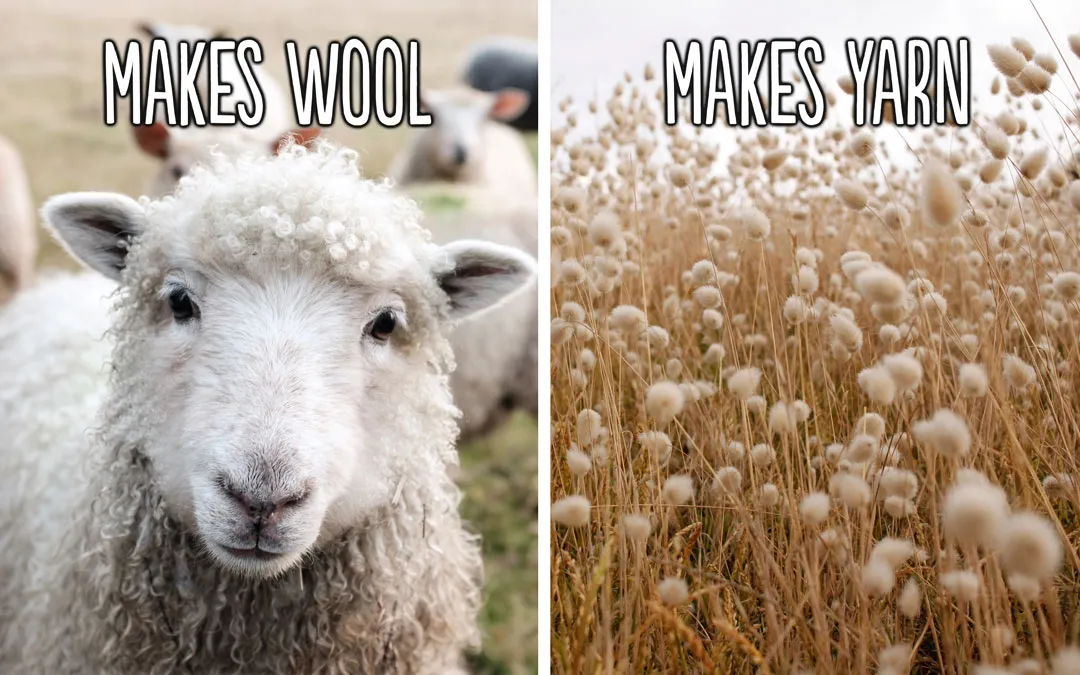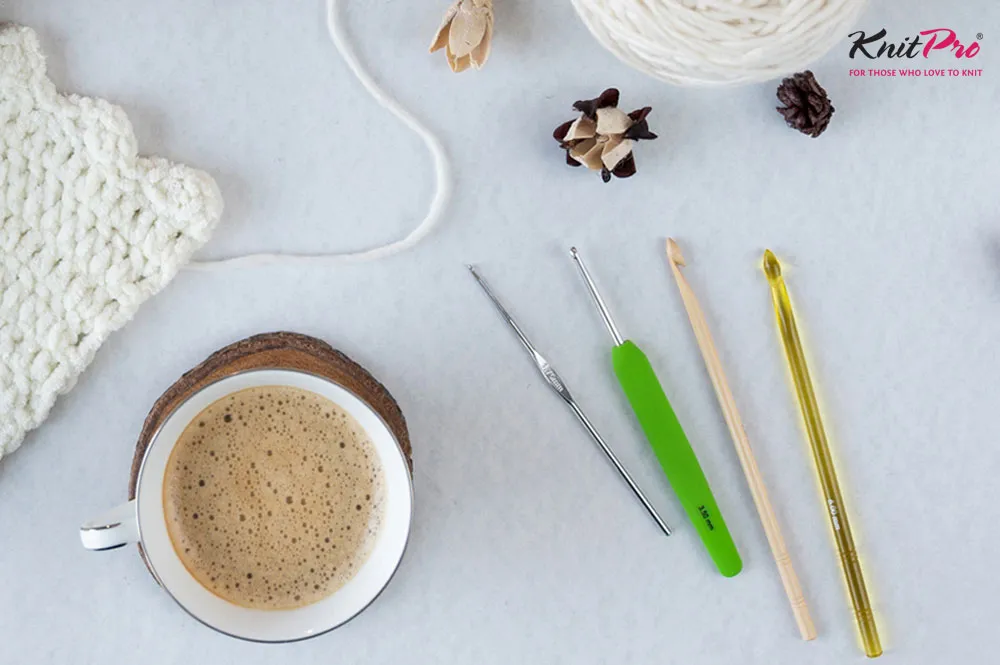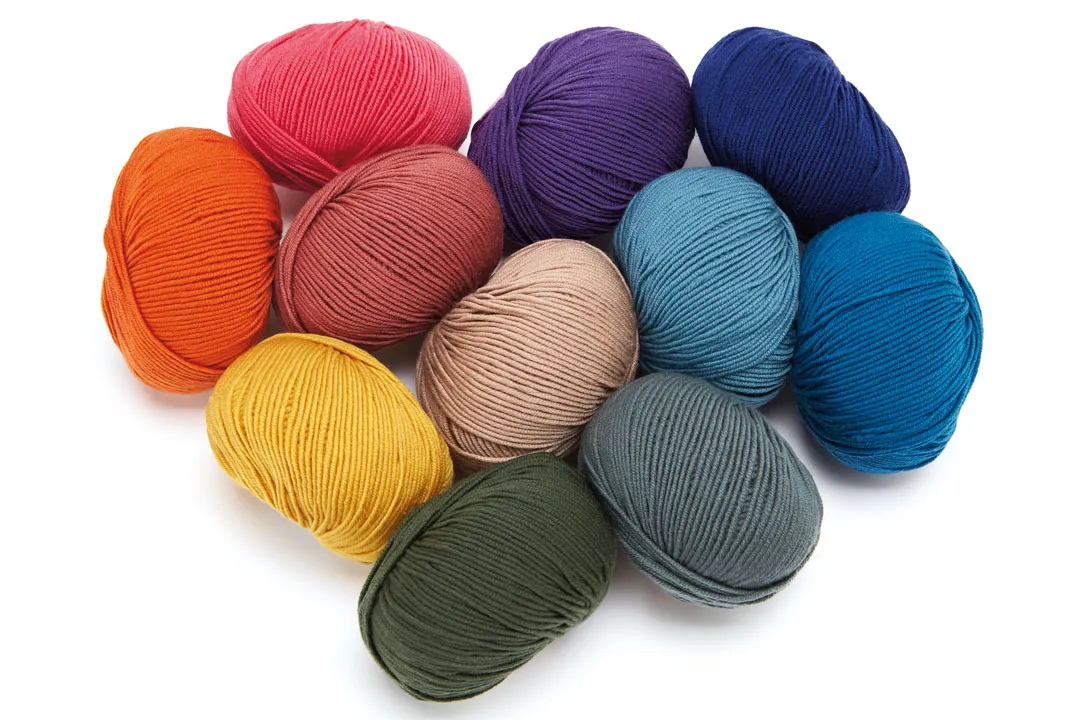You've learnt your first few crochet stitches and are officially 'hooked'. Now it's time to immerse yourself into the wonderful world of crochet yarn, and there's so much to choose from.
Here's some handy yarn guides to ensure you pick the right types of yarn for your project! Let's start with the basics - what is yarn?
What's the difference between crochet wool and crochet yarn?
Yarn is the general cover-all term for anything that is 'spun thread used for knitting, weaving, or sewing' ... and crochet too!
Wool, however, is yarn made specifically from sheep, goats or similar animals - as well as being a useful fact to know it's also important to consider if you are concerned about using animal products.

What is the best crochet yarn for beginners?
A Dk weight yarn in acrylic, wool or cotton is what we would recommend as the best crochet yarn for beginners.
This is because they are generally quite uniform in thickness, plus as acrylic doesn't felt together - if you make a mistake then you can easily undo it.
Different types of yarn for crochet
Once you've mastered the basics however, the reality is that there is so much wonderful crochet yarn out there that sometimes it can be hard to choose.
The fibre content of your crochet yarn is perhaps the most important factor to consider when starting a project - do you want it to last a really long time, do you want it to be super-soft, do you want it to be eco-conscious, do you want it to be vegan friendly - the fibres make a difference to all these factors and more!
We'll take a quick look at some of the main fibre types of yarn for crochet in our yarn guide below.
-
Acrylic
Many acrylics are now surprisingly soft, available in incredibly bright colours and are very even and consistent. They're not as breathable or as absorbent as wool, but are super-strong and machine washable!
The sustainability of acrylics is a factor that divides many knitters and crocheters - after all, it is essentially plastic - however some people see this as being a positive as it lasts longer and isn't susceptible to moths or wearing down. The other plus side of acrylics is that they're usually one of the cheaper types of yarn available!

Three quick links for acrylic yarns
- Scheepjes Colour Crafter Dk from The Knitting Network
- Stylecraft Special Aran from Lovecrafts
- Paintbox Yarns Simply Chunky from Lovecrafts
You can find even more in our list of the best acrylic yarns
-
Blends
Blends are one of the most popular types of crochet yarn. Mills mix different fibres to create yarns that combine the best of both worlds. Want a summer yarn that feels light and breezy? Try cotton with lightweight acrylic. Love alpaca but it’s just too hot? An alpaca/wool or cotton mix will be perfect!
Blends also enable mills to create unusual yarns; synthetic fibres are often used to bind ‘feature’ items like sequins to the main strand of yarn. If you like expensive fibres such as cashmere, silk or wool, keep your eyes peeled for blended versions as they will often be cheaper!

Top blended yarns to try
- Sirdar Snuggly Cashmere Merino DK from Lovecrafts
- King Cole Riot Dk from Knitting Network
- Stylecraft Naturals Bamboo and Cotton Dk from Lovecrafts
-
Cotton
If you're after a crochet yarn that's going to hold up to a lot of wear and tear and doesn't have much elasticity, then cotton's are the best yarn for crochet projects that need to be strong and sturdy. They feel very smooth to crochet with, and some cottons are mercerised (a chemical process to make them even smoother and take on dye better, as well as many other positive factors).
Cotton yarns are very strong and give you nice clear stitches, but can be a bit on the heavy side. Cotton's are often reasonably priced and come in a wide range of colours. They're great for summer projects, and are are a great choice for knitters and crocheters that are allergic to animal fibres.

Three cotton yarns to get creative with
- Rico Design Ricorumi Dk from Lovecrafts
- Scheepjes Maxi Sweet Treat Lace from Wool Warehouse
- Sirdar Snuggly 100% Cotton Dk from Knitting Network
For even more choice, take a look at our roundup of the best cotton yarns.
-
Linen
Spun from flax from plants, linen is one of the first fibres ever to be spun. You can kind of think of it as a lightweight cousin to cotton - very strong but not a lot of stretch, definitely in the featherweight category.
It's highly absorbent which means that it works equally well in hot and cold weather, and due to it's light weight it's fantastic for shawls and garments (or anything that you want to drape well)

Three lovely linen yarns
- Namolio Pure Linen from Etsy
- Eco stitch hand-dyed linen yarn from Etsy
- Rowan Creative Linen from Lovecrafts
You can find even more choice in our pick of the best linen yarns
-
Wool
Wool is breathable yet highly absorbent, so if you get caught in a rain shower in a woollen jumper it will keep you dry. As long as it’s not a boiling hot day, it will also keep you cooler for the same reasons. Wool is long-lasting and softens with wear, so keep the moths away and a crochet wool jumper could last decades.
Thanks to its naturally anti-bacterial properties, wool also requires far less washing than other fibres. Use superwash yarn if you're going to wash it in a machine though, as otherwise it can felt!
Like other animal fibres, wool has a ‘memory’. If you wet it and stretch it out (blocking) it will keep the shape it dries into, making it perfect for lace, which needs ‘opening out’ after knitting or crocheting. If you’re worried about your crochet wool items being itchy, wear a short length tied around a necklace or watch and see if it irritates you.

Our favourite 100% wool crochet yarns
- West Yorkshire Spinners ColourLab Dk from Lovecrafts
- Lopi Letloppi Aran yarn form Wool Warehouse
- Drops Snow Super Chunky from Laughing Hens
-
And the rest...
There's so many more different types of yarn for crochet that we could go on all day about it, alpaca, mohair, cashmere, silk, the list goes on!
Ultimately, when it comes to the best types of yarn for crochet, it's down to what you prefer!
Get the right kit
If you're new to crocheting and want to get set upwith the best tools, check out our guide on crochet kits for beginners, or our list of the best crochet hooks.

What is yarn weight?
When people say 'yarn weight' they're not talking about how heavy it is, they're talking about how thick the strand of yarn is!
The names can be a bit misleading - for example, 4ply is a yarn weight, but a yarn can be made from 4 strands of thread spun together and NOT be a 4ply weight yarn.
Another element that can lead to confusion is that the terms used in the UK and US are different, for example, worsted weight yarn is not really a term used in the UK but is commonly used it the US. But don't worry, here's our handy yarn guide to help you out!
-
UK Lace/Crochet thread | US Fingering/10 count crochet thread
Perfect for lace shawls and delicate projects, but can be a bit tricky. Usually worked with a 2-3mm hook.
Take a look at Gathered's pick of the best crochet thread and lace yarns.

-
UK 4ply | US Fingering/sport
A favourite weight for baby clothes, motifs and lightweight jumpers or cardigans.
Find your favourite from our list of the best 4ply/fingering yarns.

-
UK Double Knitting (DK) | US Light Worsted
So called because it’s usually double the weight of 4ply, DK is the most popular yarn. It’s quick to knit and crochet with and is very versatile. Usually worked with 3.5mm - 4.5mm hook.
Learn all about double knitting yarn with Gathered.

-
UK Aran | US Fisherman/Worsted weight
Originally created for fishermen’s jumpers, aran-weight wool (or worsted weight yarn as our friends in the US call it) can be used to make many accessories and garments when DK isn’t heavy enough, and chunky is too bulky. Perfect for outdoor or warm clothing.
Find loads of inspiring yarn in our pick of the best Aran/worsted weight yarns.

-
UK Chunky | US Bulky
Heavier than aran, chunky wool is great for outdoor wear and winter jumpers. It’s ideal for beginners because the knitted or crocheted fabric will grow quickly! Usually worked with 6.5mm - 9mm hooks
Get all cosy with one of the best chunky yarns.

-
UK Super Chunky | US Super-Bulky
This weight of yarn is popular for making winter coats and jumpers. It’s also good for beginners because it produces quick results. Good for furnishings.
Go large with the best super chunky yarns.

-
UK Big | US Jumbo
Quick and easy to knit and crochet with, big yarns are ideal for winter and making bold statements. You'll need big needles or a big hook for this yarn – up to 20mm thick. Perfect for bold scarves and coats, as well as cosy cushions and throws. Can be used with hooks from around 15mm and larger!!!
Take things super-size with our pick of the best jumbo yarns.

Tips for choosing crochet yarn
Yarn weights are a great guide for choosing a suitable crochet yarn if you're using something different than what is recommended in the pattern, but there are some things to be aware of.
-
Tension
Always start by checking your tension with the yarn you're using! This is really important because even if, for example, two different yarns say they are DK weight, there can be subtle differences between the weight of the two. If you want to know more check out our guide on how to perfect your crochet tension.
If you're really set on using a yarn weight that is different to what is recommended in a pattern, things can get a bit tricky and it won't always work - but you can find out more in our guide on how to substitute yarns.
-
Dye lots
Pay attention to the dye lot numbers. You will normally find this on the ball band/label. Because of the nature of dyes, one batch of yarn can be ever so slightly different in colour to another. The difference might be subtle enough that you wouldn't notice it at first, but once you start making it can be really visible when you change from one ball to another.
-
Availability
If you're thinking about tackling a big project, the last thing you want is to run out of crochet yarn and then find out that it's no longer available! Always make sure you have enough yarn to complete your project, stockists can run out and sometimes yarns will be discontinued.

Welcome to the wonderful world of yarn
Now that you know all about the different fibres and types of yarn, you can see how it's easy to build up quite the collection. With so many colours, weights, styles and fibre combinations available, many knitters and crocheters quickly build up a significant 'yarn stash' - after all, you can never have enough yarn!
Where to buy yarn
Whether you prefer to shop in person and are looking for the best yarn shops to visit, or are looking for the best places to buy yarn online, you'll find plenty of yarn inspiration with Gathered!






